Introduction
Milk has been considered as an essential element of the diet for human since the agricultural revolution (Huth et al., 2006). As civilizations evolved, many types of dairy products, including cheese, yogurt, ice cream, and processed milk have been developed to satisfy consumers' needs. Nowadays, milk beverages supplemented with coffee have become favored milk products, with a global consumption constantly increasing.
Coffee is one of the most popular beverages and principal commodities in the world (Feria-Morales, 2002; Geel et al., 2005). World consumption of coffee annually approximately 1.9% increased over the last 50 years (Dmowski and Dabrowska, 2014). In addition, recently, the consumption of ready-to-drink (RTD) type milk beverages supplemented with coffee has increased markedly in certain countries, such as Korea, Japan, Taiwan, among others, since there are no traditional and specific images of coffee as a freshly brewed beverage. RTD type milk beverages supplemented with coffee are cheaper, more convenient to transport, and easier to store at refrigeration temperatures than fresh brewed coffee beverages, which also explains their popularity (Hsu and Hung, 2005; Petracco, 2001).
Lately, Muslim regions, including Arab and Southeast Asia have emerged as new big markets, and many companies are showing interest toward exporting their products to these parts of the world. However, most of these Muslim regions are located in subtropical or tropical zones, and have poor food distribution infrastructures. Milk products are easily deteriorated under hot conditions and should be distributed refrigerated to prevent quality degradation events, such as lipid oxidation and precipitation, among others. The shelf-life of food is the maximum length of the time between the dates of manufacture and sale ensuring the preservation of a satisfactory quality (Gyesley, 1991; Kilcast and Subramaniam, 2000). Therefore, studying the shelf-life extension allowing an effective and secure exportation of this type of products to these regions is necessary. More particularly, lipid oxidation and precipitation become serious issues during the storage or distribution of RTD type beverages due to the presence of various ingredients, and therefore, establishing suitable emulsification conditions is paramount toward solving this problem. This study was conducted to determine the optimum emulsification and homogenization conditions during the manufacture of milk beverages supplemented with coffee, in order to extend their shelf-life.
Materials and Methods
The materials used for the milk beverage were provided by Seoul F&B Co., Ltd. (Korea). Emulsifiers such as Almax 9280, Almax 9080, and sucrose fatty acid esters F160 and F110 were contributed by Ilshin Wells Co., Ltd. (Korea).
The description of the beverage components provided by Seoul F&B Co., Ltd. (Korea) are listed in Table 1. The materials were primary homogenized with a high speed homogenizer (Ultra-turrex T25, IKA Werke GmbH, Germany) and secondary homogenized with a high pressure homogenizer (Picomax MN250A, Micronox Co., Korea).
| Ingredient | (%) |
|---|---|
| Raw milk | 30.000 |
| Coffee extract | 30.000 |
| Sucrose | 5.500 |
| NaHCO3 | 0.040 |
| Etc. | 34.46 |
| Total | 100.000 |
Response surface methodology (RSM) was used to optimize the operation parameters during the manufacturing process of the coffee beverage, such as speed of primary homogenization (X1) and amount of emulsifier (X2) to be added, which ranged from 5,000 to 15,000 rpm and 0.1-0.3%, respectively (Table 2). The testing of both variables was designed by face central composite design (FCCD) approach. Thirteen experimental settings were generated and analyzed with MINITAB release 16 (Minitab Inc., State college, USA) and Design expert release 7.0 (Stat-Ease Inc., USA). The regression model equation for particle size (Y1) and zeta-potential (Y2) could be speculated as follows:
Where, a dependent variable Y expresses response (particle size or zeta-potential), β0, β1 and β2 express constant coefficients of the intercept, linear, quadratic and interaction terms, respectively. This response surface model was also used to estimate the result by isoresponse 3-D surface plots. 3-D surface plot is the reflection of the response surface in a three dimensional plane.
| Variables | Coded Xi | Coded level |
||
|---|---|---|---|---|
| −1 | 0 | +1 | ||
| Speed of primary homogenization (rpm) | X 2 | 5,000 | 10,000 | 15,000 |
| Concentration of emulsifier (%) | X 2 | 0.1 | 0.2 | 0.3 |
Particle sizes (D4,3) and zeta-potentials of coffee beverages with various emulsifiers were determined using a Zetasizer (Zen 3600, Malvern Instruments Ltd., UK). To measure particle sizes and zeta-potentials, the samples were diluted 1,000-fold with deionized water. All samples were triplicated at a constant temperature of 25°C.
The microstructures of 100-fold diluted samples were magnified 1,000-fold under a light microscope (DM 2500, Leica microsystems GmbH, Germany).
The pH values of each beverage sample were measured at 4°C using a pH meter (PP-15, Sartorius AG, Germany).
In the present study, PV was measured by the method of AOAC (1990) with slight modifications. It was measured as follows: 1-5 g samples mixed with 25 mL chloroform/acetic acid mixture (3:2), and then 1 mL potassium iodide added into the mixture and reacted in darkness. After 10 min, 30 mL distilled water and 1 mL starch solution were poured in the sample. Free iodine was titrated with 0.01 N sodium thiosulfate. The PV was indicated in milli-equivalents of active oxygen per one kilogram (mEq active O2/Kg) of processed shrimp sample, as determined using Eq. (1):
Where, a: volume of 0.01 N sodium thiosulfate (mL), b: volume of 0.01 N sodium thiosulfate in blank (mL), M: mass of sample and f: factor of sodium thiosulfate solution.
Color values of each beverage sample were measured using a colorimeter (CT-340, Minolta, Japan), which was calibrated using original standard plate with its original value (X=97.83, Y=81.58, Z=91.51). Analyzed L*, a*, and b* values denote lightness, redness, and yellowness, respectively, in artificial light. These were measured in triplicates.
Ten panelists (5 males and 5 females) were selected from graduate school students at Kangwon National University in Korea. They were all non-smokers, healthy, and their average age was 26 years old (range 23-39 years old). The samples were stored at 4°C for 12 d, dispensed into 50 mL clear plastic cups with lids, labeled with random 4-digit codes, and served with a glass of water for cleansing of the mouth between each sample. Brownness, coffee flavor, milk flavor, rancid flavor, sweetness, bitterness, and overall acceptability were evaluated on a 5-point scale (1: none, 3: moderate, 5: very strong).
Results and Discussion
To select a suitable emulsifier, various milk beverages were manufactured with the same amount of 4 types of emulsifier, and their particle sizes as well as zeta-potentials were measured. As shown in Fig. 1, the particle sizes of most samples were below 200 nm except for the sucrose fatty acid F160 added group, and there was no statistical significance among the samples (p<0.05). The zeta-potential results (Fig. 2) showed no statistical significance among all samples (p<0.05). Sucrose fatty acid esters F110 and F160 were in powder form, and Almax 9280 and 9080 were in gel form with high viscosities. Gel-type emulsifiers with high viscosity are often considered as being inconvenient for manufacturing procedures and therefore, the powder-type emulsifiers were selected. It is known that the hydrophilic lipophilic balance (HLB) of sucrose fatty acid ester F110 is 11, while that of F160 is 15-16. Emulsifiers with high HLB are good for particle size reduction (Sjöström et al., 1993) and possess good emulsifying properties in O/W emulsion (Sjöström et al., 1993; Yin and Walker, 1994). However, the F110 showed better results than the F160. Potential interactions with proteins and carbohydrates, among others, could be occurring in the case of this beverage, and therefore, further studies need to be carried out to investigate these phenomena.
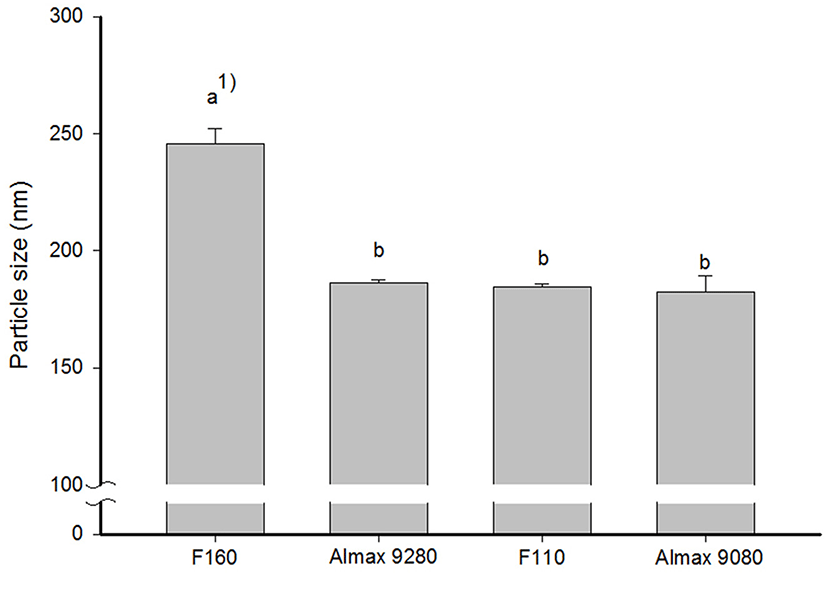
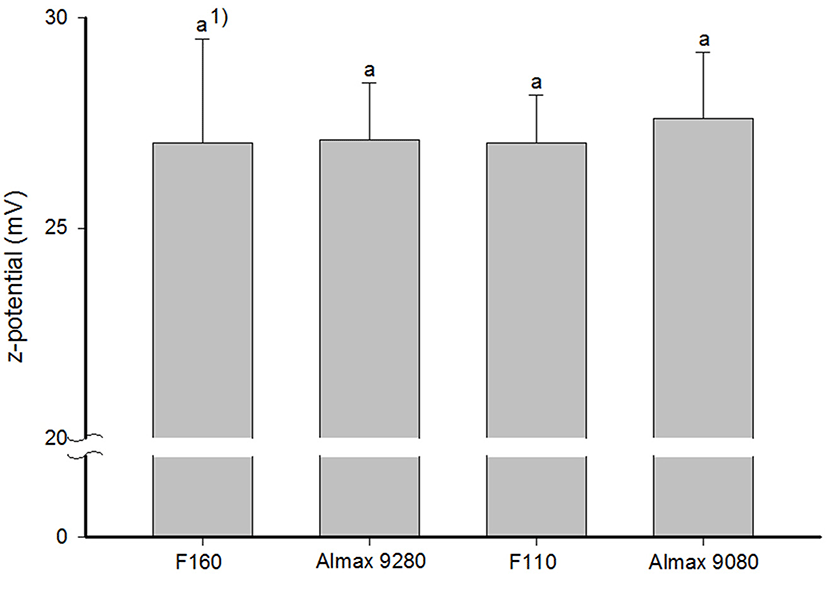
A total of 13 experiments were conducted (Table 3) using primary homogenization speed (X1) and amount of emulsifier (X2) as independent variables and particle size (Y1) as well as zeta-potential (Y2) as responses by FCCD, and the result are indicated in Table 4. The mathematical expression of the relationship between particle size and variables X1 (primary homogenization speed) and X2 (amount of emulsifier) are given as coded factors.
1)X1 and X2 are speed of primary homogenization and the concentration of emulsifier (%), respectively.
2)Y1 and Y2 are the particle sizes and zeta-potentials of milk beverages, respectively.
1)Y1 and Y2 are the particle sizes and zeta-potentials of milk beverages, respectively.
The regression of zeta-potential from variables X1 and X2 are also given below as coded factors.
A positive coefficient denotes a synergistic effect, on the other hand, a negative one denotes an antithetical effect (Simmons, 1978). In Eq. (1), X1 (primary homogenization speed) and X2 (amount of emulsifier) showed a positive relationship with particle size, indicating that an increase in the particle size would occur with an increase of these factors. In Eq. (2), X1 showed a negative relationship, whereas X2 displayed a positive relationship with the zeta-potential.
The 3-D response surfaces and contour plots for particle sizes and zeta-potentials in the coffee beverages are shown in Figs. 3(A) and 3(B), respectively. As both the homogenization speed and the amount of emulsifier increased, the droplet size and zeta-potential decreased. This result is similar to that obtained in the report by Qian and McClements (2011). They manufactured nanoemulsions with corn oil using various concentrations of emulsifier, and analyzed their average droplet diameter. As a result, a decrease in the average droplet diameter of the nanoemulsions was observed with increasing amounts of emulsifier. It is thought that higher amounts of emulsifier should allow a faster coverage of the surfaces of any new droplet formed during homogenization (Qian and McClements, 2011), which also correlates with the results obtained by Nakauma et al. (2008). They analyzed changes in zeta-potentials and average diameters of O/W emulsions elaborated with triglyceride oil and various concentrations of emulsifier. In their study, it was revealed that as the amount of emulsifier increased, both the zeta-potential and the average diameter decreased.
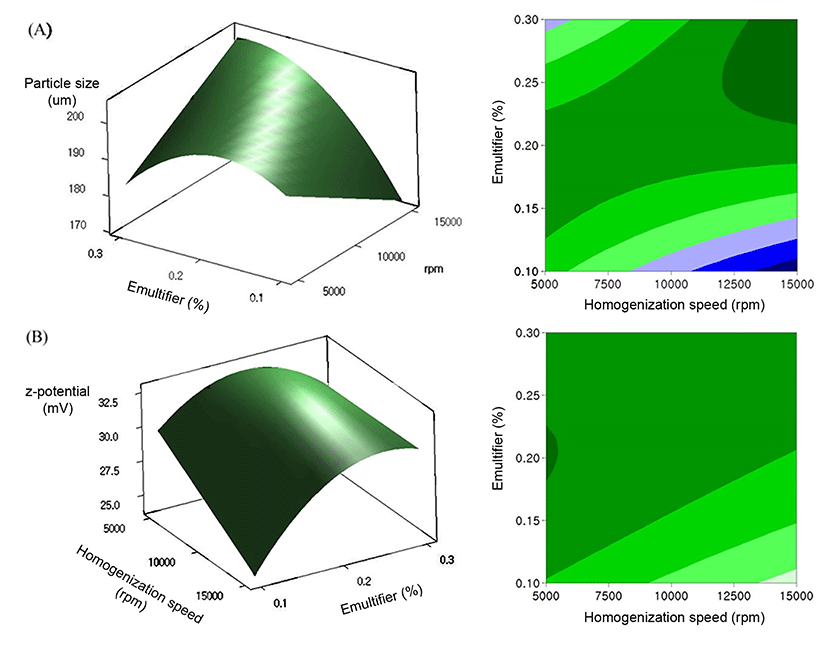
Optimization curves help to establish the factor setting that allows optimizing a single or set of responses. It is useful tool for determining the operating conditions that will lead to a desired response (Ahn et al., 2013). In the present study, the objective was to investigate the optimum conditions to produce a milk beverage supplemented with coffee, using two responses. As shown in Fig. 4, as primary homogenization speed increased, particle size increased, and zeta-potential decreased. In addition, as the amount of emulsifier increase by 0.2071%, the zeta-potential increased. Therefore, the best combination of factors to achieve the desired responses was found to be the primary homogenization speed (5,000 rpm) and the amount of emulsifier (0.2071%). Combining those factors yielded the minimum particle size and maximum zeta-potential at the same time when manufacturing the beverage. Finally, the particle size and zeta-potential of the beverage under the optimum condition were 190.1 nm and −25.94±0.06 mV, respectively (Fig. 5). In this result, particle size was nearly agreed with the estimation by RSM. However, the zeta-potential value was slightly smaller than the estimation by RSM.
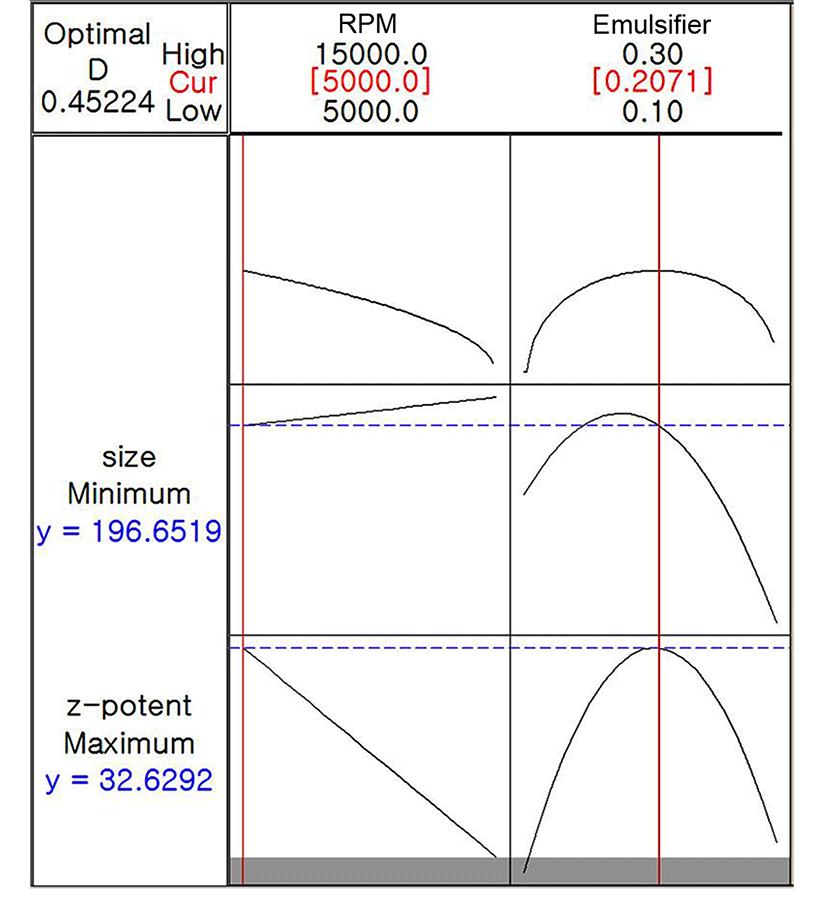
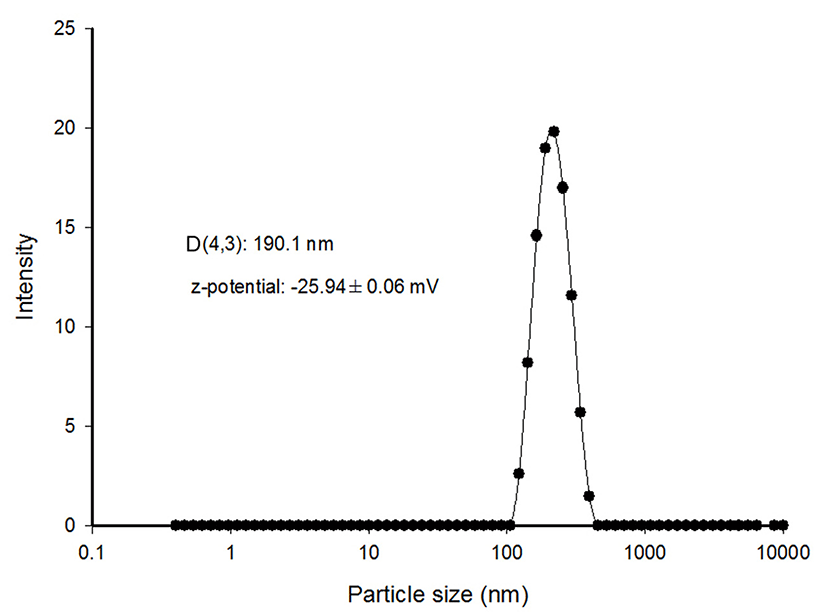
The changes in pH of the coffee beverage stored at 4°C for 12 d are depicted in Fig. 6. The pH values of all samples were almost consistent during 12 d of storage. The pH of the sucrose fatty acid F160 added group (GF160) and the sucrose fatty acid F110 added group (GF110) ranged from 6.59 to 6.63 and 6.56 to 6.65, respectively. In the present study, the pH of these beverages were higher than those reported by Moon et al. (2009), where the pH of coffee beverages ranged from 4.90 to 6.18, due to the presence of total chlorogenic acid in coffee beans, directly related to the roasting conditions of the green coffee beans. It is considered that sodium bicarbonate functioned as a pH controller in this beverage.
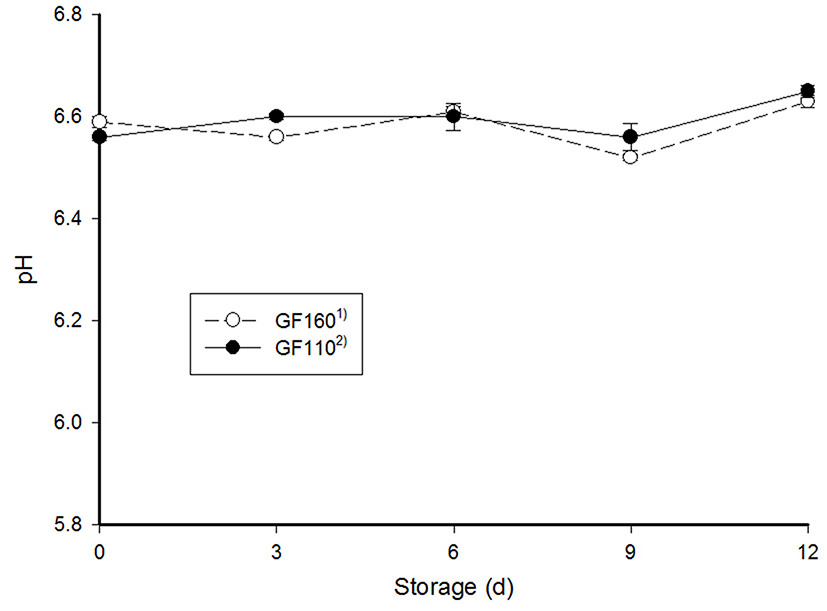
Fig. 7 shows the changes in PV of coffee beverages stored during 30 d at 4°C. The PV of all samples increased during storage. The PV of the GF160 was higher than that of the GF110. Furthermore, its PV rapidly increased after 12 d, reaching a value of 20 meq/Kg or more after 24 d. In contrast, the PV of the GF110 only increased from 1.41 to 13.0 meq/Kg during storage. In general, PV above 10-15 meq/Kg reflect oxidized fat (Joint FAO/WHO, 1999). It is thought that the milk fat globules of the GF110 were better dissolved by the selected emulsifier, sucrose fatty acid ester F110, than those of the GF160, potentially minimizing their floating properties and consequently, their chance of entering in contact with headspace oxygen. Therefore, using sucrose fatty acid ester F110 was an effective way to prevent lipid oxidation in this beverage.
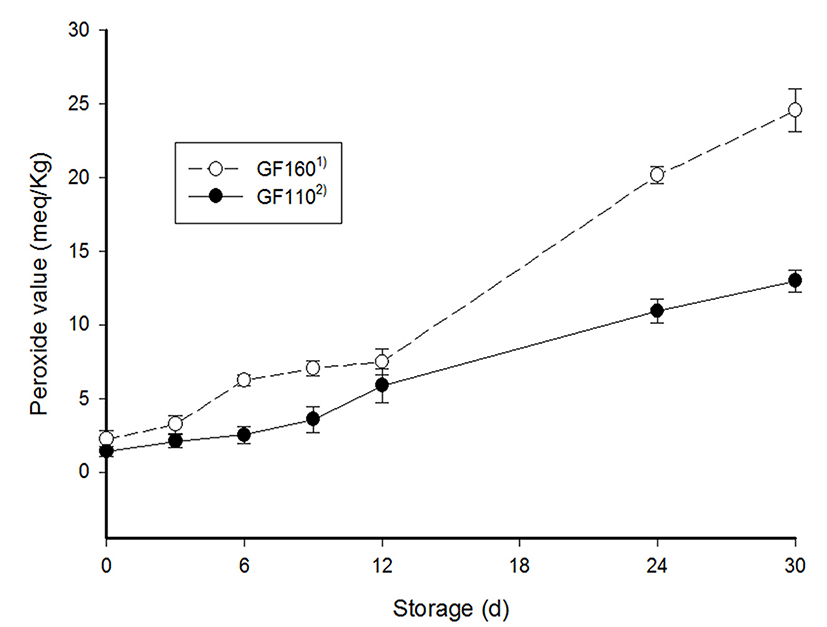
To determine the stability of the beverages during storage, their zeta-potentials and particle size distributions were measured and are presented in Figs. 8 and 9, respectively. The zeta-potential of the GF110 was higher than that of the GF160 after 6 d. It is known that a higher zeta-potential corresponds to greater particle stability (Freitas and Müllerä, 1998). Regarding size distribution of the beverages (Fig. 9), there were not changes within the GF 110. In contrast, the particle size distribution of the GF160 increased during storage. Initially, the size distribution curve was sharp as well as monomodal, and remained stable. However, it gradually moved toward the right-hand side after the 12th storage day, indicating an increased droplet size. Moreover, particles above 3,000 nm were observed. This result accords with the report by Nasrabadi et al. (2016) showing that the droplet size of conjugated linoleic acid (CLA) beverage emulsions manufactured with 3.5% (w/w) CLA, 10% (w/w) gum Arabic, and 0.3% (w/w) xanthan gum gradually increased with time. Finally, the droplet size distribution curve of the control also became broader after 30 d of storage. A broad size distribution is suspected to be denotative of a population of irreversibly aggregated droplets formed with the passage of time after homogenization (Soleimanpour et al., 2012).
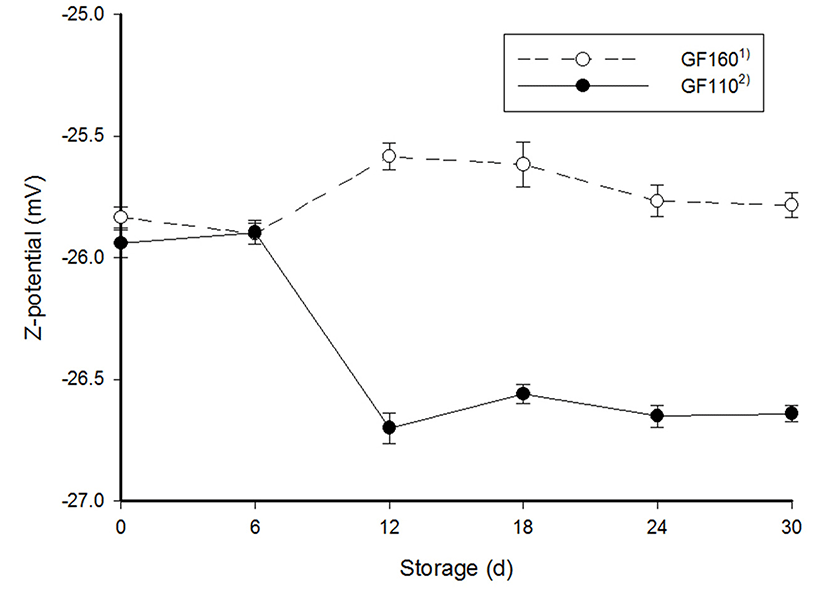
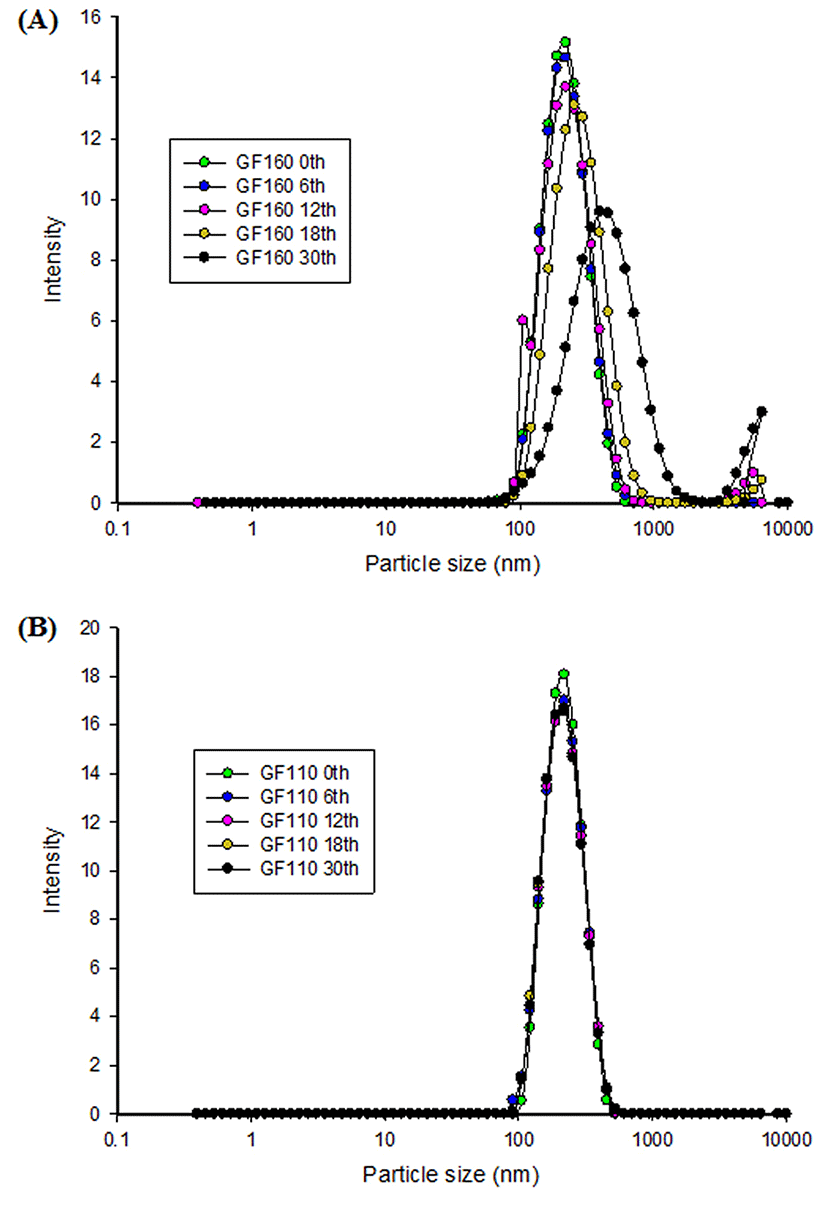
The microstructures of the particles are indicated in Fig. 10. Initially, the particles of the GF160 and GF110 displayed rounded surfaces, and were evenly distributed. The particle size in the GF160 tended to increase during storage, in relation with the increase in average droplet size of the GF160 mentioned above. However, in the GF110, no changes in droplet size were observed. Sucrose fatty acid ester F110 may provide a higher fat globules emulsion level in the beverage than F160, and as a result, prevent particle aggregation more efficiently. Therefore, it was established that sucrose fatty acid ester F110 was more suitable than F160 for the manufacture of this beverage.
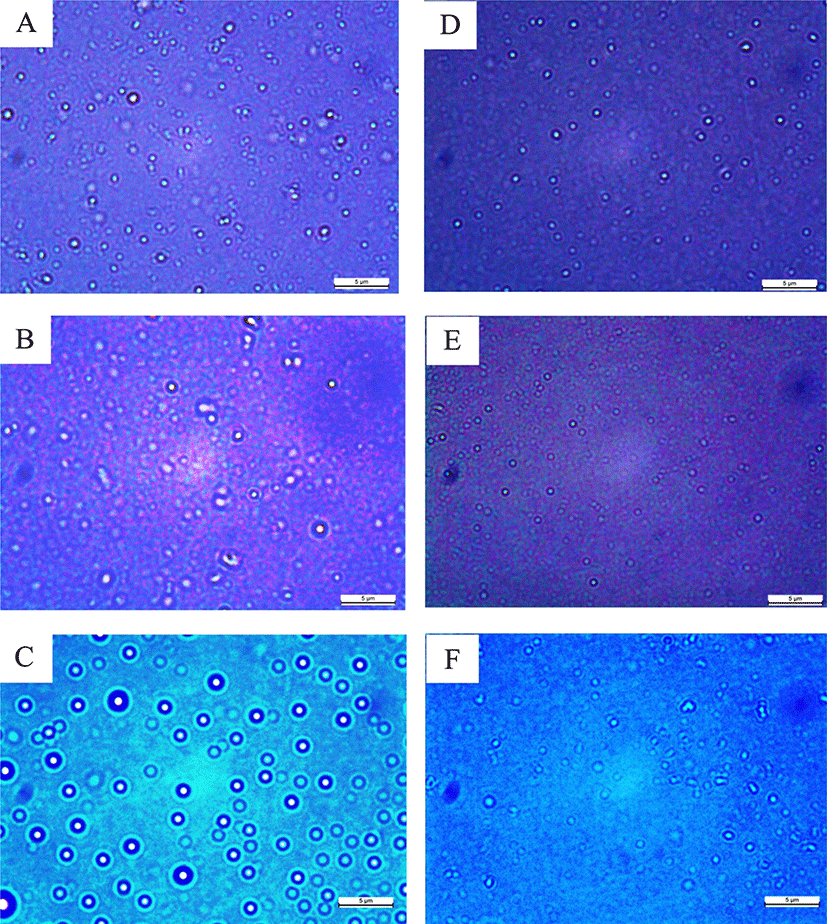
Table 5 presents the changes in color of coffee beverages during 12 d of storage at 4°C. The L* values of either GF110 or GF160 significantly decreased during storage (p<0.05). However, for a given day, different group types did not show significant differences in L* values during storage. According to McClements (2002), L* values increase as the droplet semidiameter decreases from 10 to 0.1 μm. Lightness depends on the direction of light scattering. As the droplet radius increases, the light gets progressively dispersed toward the forward direction, while a smaller fraction of light gets dispersed backwards and is consequently detected as diffusedly reflected light. In this study, the average droplet size of the GF110 was around 190 μm, which was smaller than that of the GF160, and therefore, the L* value of the GF110 was higher than that of the GF160. The a* values of the GF110 were significantly higher than those of the GF160, except at the initial time point and after 6 d. The a* value of the GF160 was significantly higher than that of the GF110 initially, but there was no significant difference between the GF160 and GF 110 after 6 d (p<0.05). The b* values of the GF160 did not show significant variations during storage (p<0.05), and there were only slight changes within those of the GF 110. However, there was no significant differences between the GF160 and GF110 after 9 and 12 d (p<0.05).
1)Values with different superscript in a row (a-b) and column (A-B) are significant at p<0.05 by Duncan’s multiple range test;
2)GF160, sucrose fatty acid ester F160 added group; 3)GF110, sucrose fatty acid ester F110 added group.
The sensory properties of the milk beverages with coffee during storage at 4°C for 12 d are shown in Table 6. Brownness of either the GF160 or GF110 showed no significant differences during storage (p<0.05). Additionally, there was no significant difference between groups (p<0.05). Floating cream levels of the GF160 gradually increased after 3 d of storage, and finally, after 12 d, significantly differed from the initial value (p<0.05). Regarding the GF110, these levels increased slightly and showed no significant difference during storage. This behavior may be related to the dispersibility of fat globules in the beverages. In the same way, the size distribution, PV, and zeta-potential values of the GF110 were superior to those of the GF160, as mentioned above. Therefore, it is believed that the usage of sucrose fatty acid ester F110 as the emulsifier effectively dispersed the particles of the milk beverage and prevented floating of cream in the GF110.
1)Values with different superscript in a row (a-b) and column (A-B) are significant at p<0.05 by Duncan’s multiple range test;
2)GF160, sucrose fatty acid ester F160 added group; 3)GF110, sucrose fatty acid ester F110 added group.
The coffee flavor of GF110 was relatively higher than that of the GF160. However, this difference was not statistically significant (p<0.05). The sweetness of the control was relatively higher than that of the GF110 until day 3. However, there were no significant differences after this time point. In contrast, the bitterness of the GF110 was generally higher than that of the GF160, showing a significant difference initially (p<0.05). Sweetness is known to reduce bitterness in beverages. This result correlates with a report by Li et al. (2014), who showed that there was a negative correlation between coffee flavor and sweetness in coffee-flavored milk. Li et al. (2014) investigated the correlations between various sensory properties in coffee-flavored milk. In their study, coffee flavor was negatively influenced by sweetness. Similarly, Pangborn (1982) and Anzueto et al. (1995) also mentioned that the addition of sucrose decreases the sensory perception of bitterness in coffee beverages. Calvino et al. (1990) found that the restraint of bitterness and coffee flavor increased with enhanced sweetness. Moreover, Li et al. (2014) reported that sweetness is positively correlated with milk flavor. The milk flavor of the GF160 was relatively higher than that of the GF110 in the present study, even though it did not show a statistically significant difference (p>0.05). Rancid flavor gradually increased within all groups. However, there was no significant difference during storage (p<0.05). The rancid flavor of the GF110 was lower than that of the GF160, but this difference was not statistically significant (p<0.05). This particularity may also be due to dispersibility properties and floating cream levels, and well dispersed milk beverages, containing sucrose fatty acid ester F110, would not have floating fat globules and consequently, not form cream lines, reducing any potential contacts with headspace oxygen which therefore, would prevent rancid flavor from occurring. The other sensory properties, except for the overall acceptability, did not show significant differences between the GF160 and GF110 during storage (p<0.05). Overall acceptability of the GF 110 was significantly lower than that of the GF160 between the initial time point and day 3 of the storage period (p<0.05). However, this difference was not significant anymore beyond 3 d of storage (p<0.05).
Conclusions
The present study indicated that the optimum conditions to manufacture of the beverage supplemented with coffee by RSM were 5,000 rpm of primary homogenization speed and approximately 0.2% emulsifier addition. Also, the qualitative properties of milk beverages supplemented with coffee emulsified with sucrose fatty acid ester F110 was superior to that obtained with F160 in terms of peroxide value, particle size distribution, zeta-potential, dispersibility, and rancid flavor. Especially, improvement of dispersibility by the F110 affected PV. It means that using the F110 into the beverage could effectively extend its shelf-life. Additionally, other properties of the beverages such as pH, brownness, coffee flavor, and tastes showed no significant difference between the GF160 and GF110. Based on the results obtained from the present study, it is considered that the application of sucrose fatty acid F110 into milk beverage supplemented with coffee can effectively prolong their shelf-life, even though further studies performing accelerated shelf-life tests are needed to provide a deeper understanding of the phenomena involved.













